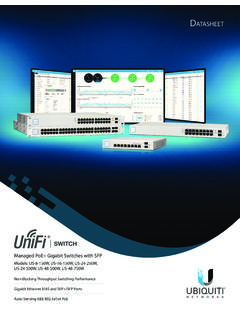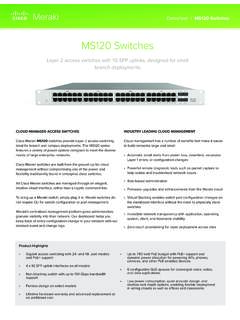Transcription of Configuring 802.1X Port-Based Authentication
1 C H A P T E R 10. Configuring Port-Based Authentication This chapter describes how to configure IEEE Port-Based Authentication on the Catalyst 3750. switch . As LANs extend to hotels, airports, and corporate lobbies, creating insecure environments, prevents unauthorized devices (clients) from gaining access to the network. Unless otherwise noted, the term switch refers to a standalone switch and to a switch stack. Note For complete syntax and usage information for the commands used in this chapter, refer to the command reference for this release. This chapter consists of these sections: Understanding Port-Based Authentication , page 10-1. Configuring Authentication , page 10-10. Displaying Statistics and Status, page 10-20. Understanding Port-Based Authentication The IEEE standard defines a client-server- based access control and Authentication protocol that restricts unauthorized clients from connecting to a LAN through publicly accessible ports .
2 The Authentication server authenticates each client connected to a switch port before making available any services offered by the switch or the LAN. Until the client is authenticated, access control allows only Extensible Authentication Protocol over LAN (EAPOL), Cisco Discovery Protocol (CDP), and Spanning Tree Protocol (STP) traffic through the port to which the client is connected. After Authentication is successful, normal traffic can pass through the port. These sections describe Port-Based Authentication : Device Roles, page 10-2. Authentication Initiation and Message Exchange, page 10-3. ports in Authorized and Unauthorized States, page 10-4. Supported Topologies, page 10-5. Using with Port Security, page 10-5. Using with Voice VLAN ports , page 10-6. Using with VLAN Assignment, page 10-7. Using with Guest VLAN, page 10-8. Catalyst 3750 switch Software configuration Guide 78-15164-04 10-1.
3 Chapter 10 Configuring Port-Based Authentication Understanding Port-Based Authentication Using with Per-User ACLs, page 10-8. and switch Stacks, page 10-9. Device Roles With Port-Based Authentication , the devices in the network have specific roles as shown in Figure 10-1. Figure 10-1 Device Roles Authentication server (RADIUS). Workstations (clients). 101229. Client the device (workstation) that requests access to the LAN and switch services and responds to requests from the switch . The workstation must be running client software such as that offered in the Microsoft Windows XP operating system. (The client is the supplicant in the IEEE specification.). Note To resolve Windows XP network connectivity and Authentication issues, read the Microsoft Knowledge Base article at this URL: Authentication server performs the actual Authentication of the client.
4 The Authentication server validates the identity of the client and notifies the switch whether or not the client is authorized to access the LAN and switch services. Because the switch acts as the proxy, the Authentication service is transparent to the client. In this release, the RADIUS security system with Extensible Authentication Protocol (EAP) extensions is the only supported Authentication server. It is available in Cisco Secure Access Control Server version or later. RADIUS operates in a client/server model in which secure Authentication information is exchanged between the RADIUS server and one or more RADIUS clients. switch (edge switch or wireless access point) controls the physical access to the network based on the Authentication status of the client. The switch acts as an intermediary (proxy) between the client and the Authentication server, requesting identity information from the client, verifying that information with the Authentication server, and relaying a response to the client.
5 The switch includes the RADIUS client, which is responsible for encapsulating and decapsulating the EAP frames and interacting with the Authentication server. When the switch receives EAPOL frames and relays them to the Authentication server, the Ethernet header is stripped and the remaining EAP frame is re-encapsulated in the RADIUS format. The EAP. frames are not modified or examined during encapsulation, and the Authentication server must Catalyst 3750 switch Software configuration Guide 10-2 78-15164-04. Chapter 10 Configuring Port-Based Authentication Understanding Port-Based Authentication support EAP within the native frame format. When the switch receives frames from the Authentication server, the server's frame header is removed, leaving the EAP frame, which is then encapsulated for Ethernet and sent to the client. The devices that can act as intermediaries include the Catalyst 3750, Catalyst 3560, Catalyst 3550, Catalyst 2970, Catalyst 2955, Catalyst 2950, Catalyst 2940 switches, or a wireless access point.
6 These devices must be running software that supports the RADIUS client and Authentication Initiation and Message Exchange The switch or the client can initiate Authentication . If you enable Authentication on a port by using the dot1x port-control auto interface configuration command, the switch must initiate Authentication when the link state transitions from down to up. It then sends an EAP-request/identity frame to the client to request its identity (typically, the switch sends an initial identity/request frame followed by one or more requests for Authentication information). Upon receipt of the frame, the client responds with an EAP-response/identity frame. However, if during bootup, the client does not receive an EAP-request/identity frame from the switch , the client can initiate Authentication by sending an EAPOL-start frame, which prompts the switch to request the client's identity.
7 Note If is not enabled or supported on the network access device, any EAPOL frames from the client are dropped. If the client does not receive an EAP-request/identity frame after three attempts to start Authentication , the client sends frames as if the port is in the authorized state. A port in the authorized state effectively means that the client has been successfully authenticated. For more information, see the ports in Authorized and Unauthorized States section on page 10-4. When the client supplies its identity, the switch begins its role as the intermediary, passing EAP frames between the client and the Authentication server until Authentication succeeds or fails. If the Authentication succeeds, the switch port becomes authorized. For more information, see the ports in Authorized and Unauthorized States section on page 10-4. The specific exchange of EAP frames depends on the Authentication method being used.
8 Figure 10-2. shows a message exchange initiated by the client using the One-Time-Password (OTP) Authentication method with a RADIUS server. Catalyst 3750 switch Software configuration Guide 78-15164-04 10-3. Chapter 10 Configuring Port-Based Authentication Understanding Port-Based Authentication Figure 10-2 Message Exchange Authentication Client server (RADIUS). EAPOL-Start EAP-Request/Identity EAP-Response/Identity RADIUS Access-Request EAP-Request/OTP RADIUS Access-Challenge EAP-Response/OTP RADIUS Access-Request EAP-Success RADIUS Access-Accept Port Authorized EAPOL-Logoff 101228. Port Unauthorized ports in Authorized and Unauthorized States Depending on the switch port state, the switch can grant a client access to the network. The port starts in the unauthorized state. While in this state, the port disallows all ingress and egress traffic except for , CDP, and STP protocol packets.
9 When a client is successfully authenticated, the port transitions to the authorized state, allowing all traffic for the client to flow normally. If a client that does not support is connected to an unauthorized port, the switch requests the client's identity. In this situation, the client does not respond to the request, the port remains in the unauthorized state, and the client is not granted access to the network. In contrast, when an client connects to a port that is not running the protocol, the client initiates the Authentication process by sending the EAPOL-start frame. When no response is received, the client sends the request for a fixed number of times. Because no response is received, the client begins sending frames as if the port is in the authorized state. You control the port authorization state by using the dot1x port-control interface configuration command and these keywords: force-authorized disables Authentication and causes the port to transition to the authorized state without any Authentication exchange required.
10 The port sends and receives normal traffic without Authentication of the client. This is the default setting. force-unauthorized causes the port to remain in the unauthorized state, ignoring all attempts by the client to authenticate. The switch cannot provide Authentication services to the client through the port. auto enables Authentication and causes the port to begin in the unauthorized state, allowing only EAPOL frames to be sent and received through the port. The Authentication process begins when the link state of the port transitions from down to up or when an EAPOL-start frame is received. The switch requests the identity of the client and begins relaying Authentication messages between the client and the Authentication server. Each client attempting to access the network is uniquely identified by the switch by using the client MAC address.














